
|
|
|
|
BY: SUN STAFF
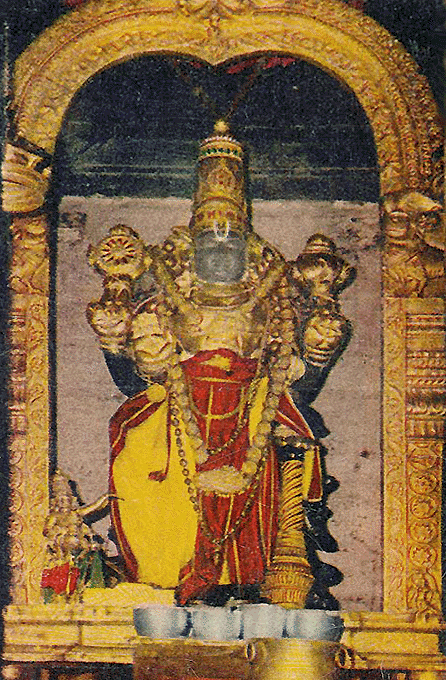
Lord Varadaraja at Visnu-kanci Mar 10, CANADA (SUN) — A serial exploration of the holy sites visited by Lord Caitanya. Visnu-kanci
Today we explore another of the holy sites in Tamil Nadu visited by Lord Caitanya during his preaching expedition to South India. In the summary of Sri Caitanya-caritamrta Madhya Lila is mentioned Visnu-kanci:
Madhya lila 9 "A summary of the Ninth Chapter is given by Srila Bhaktivinoda Thakura. After leaving Vidyanagara, Sri Caitanya Mahaprabhu visited such places of pilgrimage as Gautami-ganga, Mallikarjuna, Ahovala-nrsimha, Siddhavata, Skanda-ksetra, Trimatha, Vrddhakasi, Bauddha-sthana, Tirupati, Tirumala, Pana-nrsimha, Siva-kanci, Visnu-kanci, Trikala-hasti, Vrddhakola, Siyali-bhairavi, Kaveri-tira and Kumbhakarna-kapala." Later in Madhya Lila we get some specific details on this tirtha: Madhya 9.69
"The Lord then visited a holy place known as Visnu-kanci. There He saw Laksmi-Narayana Deities, and He offered His respects and many prayers to please Them. PURPORT
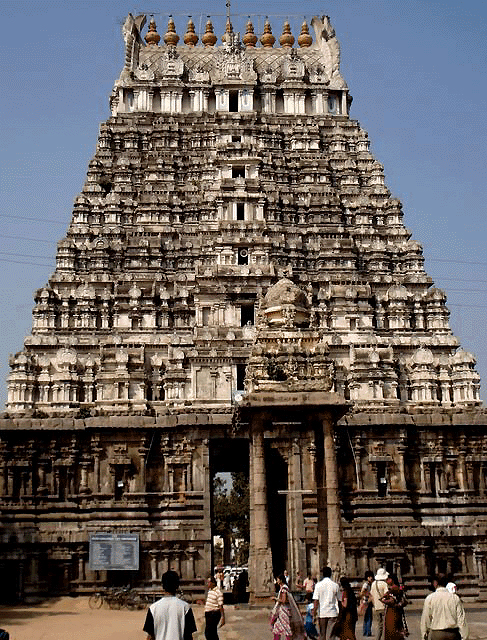
Varadaraja Temple Gopuram Madhya 9.70
"When Sri Caitanya Mahaprabhu stayed at Visnu-kanci for two days, He danced and performed kirtana in ecstasy. When all the people saw Him, they were converted into devotees of Lord Krsna." In his purport to Madhya 9.69, Srila Prabhupada describes Visnu-kanci as being five miles away from Kancipuram, and this most likely refers to the center of Kancipuram City. Kanchipuram is divided into two main sections: Shiva-kanci in the north, and Vishnu-kanci in the east. To the south is a cluster of Jain temples.
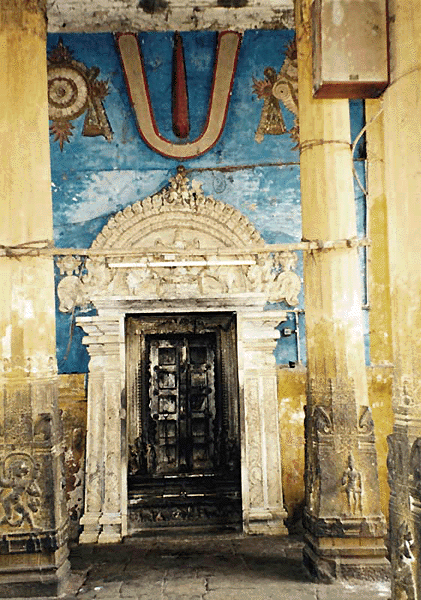
Varadaraja Perumal Temple In our recent series on the places of Lord Brahma's worship, we covered the abode of Lord Brahma at Kailasanathaswamin. It is said that there have been as many as 16,000 temples in Kanchipuram (Conjivaram) over the years. In the present age there are 13 Vaisnava Divya Desam temples in the area of Kanchi, and several Vaikuntha Perumal (Visnu) temples.
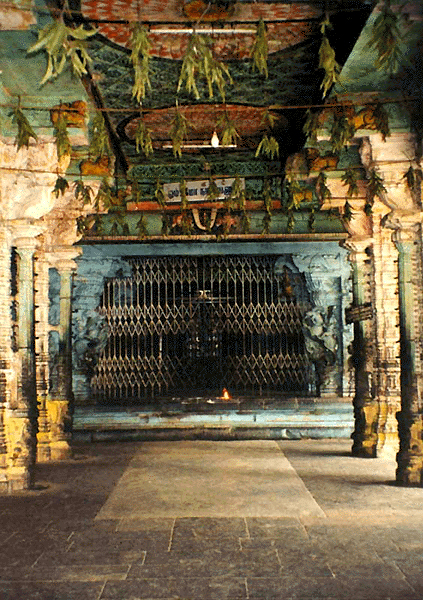
Varadaraja Temple Unfortunately, we were not able to identify a Laksmi-Narayana temple in Visnu-kanci that Lord Caitanya visited, although mention of His visit to Kanci is widely published. Given that Madhya 9.69 specifically says, "The Lord then visited a holy place known as Visnu-kanci. There He saw Laksmi-Narayana Deities", it may well be that these Deities were residing in a temple presided over by another personality, perhaps Perumal Visnu, or Laksmi-Nrsimha, rather than residing in a temple dedicated to Them by name. Of the 13 Divya Desams in Kancipuram, those revered by the Alvars in Visnu-kanci include Attigiri (home of the Varadaraja Perumal temple mentioned in Madhya 9.69), Ashtabuyakaram, Tiruttankaa, Tiruvelukkai and Tiruvegkaa. None of these temples appear to have Laksmi-Narayana in residence, however. About 15 km outside of Kanchipuram is a small village called Neervalur, where there is a temple of Lord Laksmi-Narayana, said to be about 500 years old. There is also a shrine for Jwala-Nrimshadeva there. This temple was once known as Sri Bashyapuram, a reference to the bhasya of Ramanujacarya. The temple is under the management of Ahobila Matha. Other than it's relatively close proximity to Kancipuram, however, we have no reason to think that it might have been visited by Lord Caitanya.
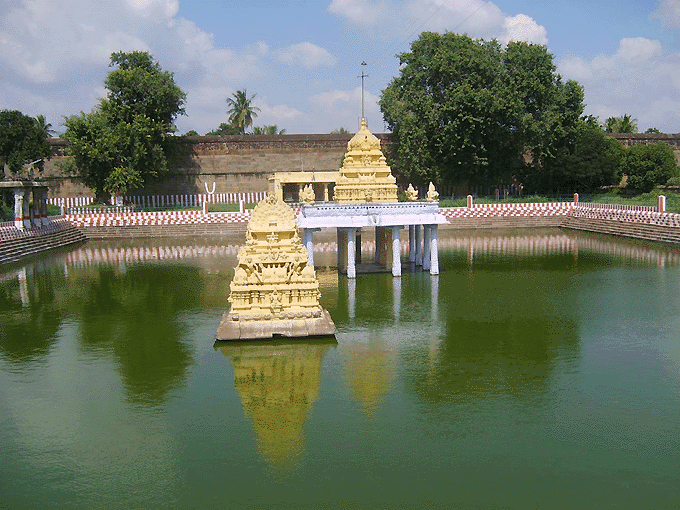
Ananta Sarovar at Visnu-kanci Kancipuram is one of the seven primary dhamas in India, along with Varanasi, Haridwar, Ujjain, Mathura, Ayodhya and Dvaraka. Kanchi is mentioned in the Mahabhasya of Patanjali from the 2nd century BC, and has been visited by many transcendental personalities, including Lord Balarama, Nityananda Prabhu, Sri Madhvacarya, and Ramanujacarya. The name 'Kanchi' comes from 'ka' (Brahma) and 'anchi' (worshipped), which refers to the fact that Brahmadeva worshipped the Lord here. Before going on to describe the temple of Lord Varadharaja, mentioned in Madhya 9.69, we would like to point out the mention of Visnu-kanci tirtha found later in Madhya Lila, at Madhya 20.217-219. It's interesting to note the context in which Visnu-kanci is mentioned, obviously emphasized as a highly important spiritual dhama. These slokas and purports clearly state how important the Lord's Abodes and Forms are, helping us to understand the great importance of Sri Caitanya's visit to Visnu-kanci. Madhya 20.217
"At Visnu-kanci there is Lord Visnu, at Mayapur Lord Hari, and throughout the universe a variety of other forms. PURPORT No one should consider the Deity in the temple to be made of stone or wood, nor should one consider the spiritual master an ordinary human being. No one should consider a Vaisnava to belong to a particular caste or creed, and no one should consider caranamrta or Ganges water to be like ordinary water. Nor should anyone consider the Hare Krsna maha-mantra to be a material vibration. All these expansions of Krsna in the material world are simply demonstrations of the Lord's mercy and willingness to give facility to His devotees who are engaged in His devotional service within the material world. Madhya 20.218
"Within the universe the Lord is situated in different spiritual manifestations. These are situated on seven islands in nine sections. Thus Their pastimes are going on. PURPORT The seven islands are mentioned in the Siddhanta-siromani:
The seven islands (dvipas) are known as (1) Jambu, (2) Saka, (3) Salmali, (4) Kusa, (5) Kraunca, (6) Gomeda, or Plaksa, and (7) Puskara. The planets are called dvipas. Outer space is like an ocean of air. Just as there are islands in the watery ocean, these planets in the ocean of space are called dvipas, or islands in outer space. There are nine khandas, known as (1) Bharata, (2) Kinnara, (3) Hari, (4) Kuru, (5) Hiranmaya, (6) Ramyaka, (7) Ilavrta, (8) Bhadrasva and (9) Ketumala. These are different parts of Jambudvipa. A valley between two mountains is called a khanda or varsa." Madhya 20.219
"The Lord is situated in all the universes in different forms just to please His devotees. Thus the Lord destroys irreligious principles and establishes religious principles. PURPORT
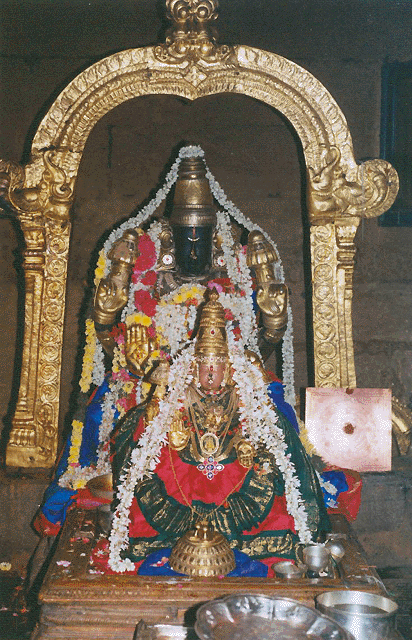
Laksmi Devi with Lord Varadaraja As is mentioned in Madhya 9.69, Lord Varadaraja resides at Visnu-kanci, and Madhya 20.217 indicates that He is the prime personality at Visnu-kanci. The Varadharaja Perumal Temple, also known as Hastagiri or Attiyuran, is very famous. It was originally built by the Pallavas in 1053, and was expanded by the Chola kings. Ramanuja resided at this temple, which is situated on a large 23-acre complex housing the main Varadaraja Swami Temple and the shrine of Lord Yoga-Narasimhaswami in the cave below Hasatgiri Hill, with a separate shrine for Perundevi Tayar, the consort of Lord Varadaraja.
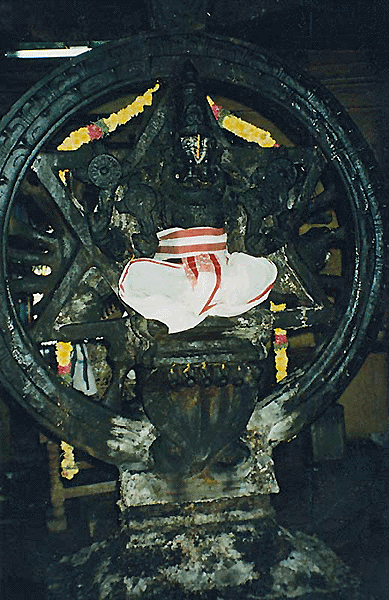
Sri Yoga-Nrsimhadeva at Varadaraja Temple The temple architecture and carvings at the Varadaraja Temple are truly spectacular, and devotees and visitors throng here to enjoy the beauty. As mentioned above, Lord Nityananda visited Visnu-kanci. After leaving His parental home, he traveled to many of the same tirthas Lord Caitanya visited, up to the 20th year of age. In Caitanya Bhagavata by Sri Vrindavana Dasa Thakur, in the Summary of Adi lila Chapter 9, we read: "Thereafter Sri Nityananda travelled to the holy city of Dvaraka and bathed in the ocean, feeling great spiritual bliss. Next He went to Siddhapura. That place was rendered holy by the presence of Lord Kapila. After that Nityananda went to Matsya Tirtha where He gave away grains in charity on the occasion of a big festival. The Lord visited Siva-Kanci and Vishnu-kanci. Being the original Supreme Person, Nityananda was amused at the fanatical conflict that existed between the followers of Lord Siva and Lord Vishnu." In Chapter 79 of Krsna Book, we read about Lord Balarama's travels to Visnu-kanci: "The most important place of pilgrimage in southern India, or Dravida, is Venkatacala, commonly known as Balaji. After visiting this place Lord Balarama proceeded toward Visnukanci, and from there He proceeded on the bank of the Kaveri. He took His bath in the river Kaveri; then He gradually reached Rangaksetra. The biggest temple in the world is in Rangaksetra, and the Visnu Deity there is celebrated as Ranganatha. A similar temple of Ranganatha is in Vrndavana, although not as big as the temple in Rangaksetra. While going to Visnukanci, Lord Balarama also visited Sivakanci. After visiting Rangaksetra, He gradually proceeded toward Mathura, commonly known as the Mathura of southern India."
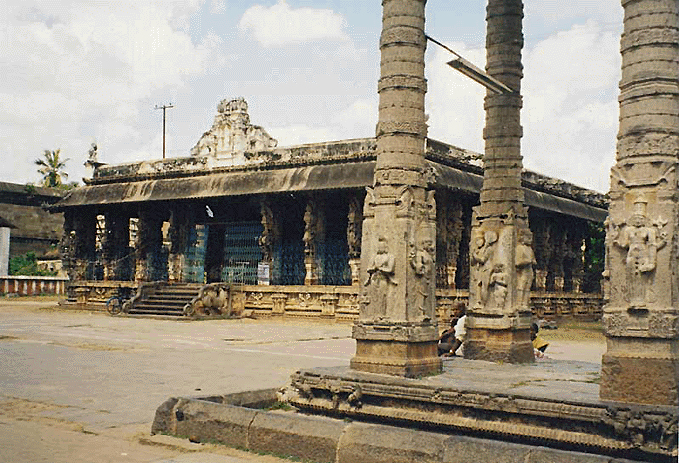
Varadaraja Temple Complex
| |